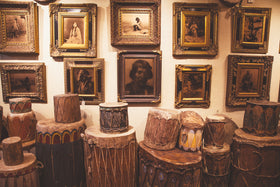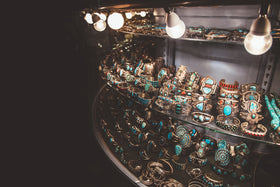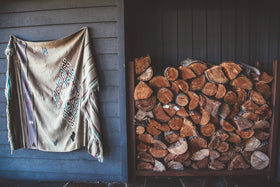History
This monumental pole is a significant piece of Northwest Coast art and Seattle history that was previously owned by Joseph Edward “Daddy” Standley, the founder of the iconic Ye Olde Curiosity Shop in Seattle, Washington. The pole was displayed for years on the grounds of Standley’s “Totem Place” estate in West Seattle, across the bay from his iconic ethnographic art and curio shop on the Seattle Waterfront. So popular amongst tourists was the Totem Place estate grounds, that the Southwest Seattle Historical Society has stated that “for decades... it was a place where tour buses stopped, and flashbulbs popped. It probably was the most gawked-at, talked-about residence in West Seattle.”
[1] This pole was even featured in situ at Standley’s West Seattle home on a postcard that was sold to visitors through Ye Olde Curiosity Shop (see Figure 1). Although the totems are long gone and the James family no longer live at Totem Place, the home remains a popular destination for visitors through tours organized by the Log House Museum in West Seattle.
[2]
While there are multitudes of model poles and other artifacts available to collectors that were sold as souvenirs from Ye Olde Curiosity Shop, objects that were actually owned by Standley are virtually unknown in the art market. The vast majority of objects that Standley esteemed and considered his private collection have remained with his family and descendants and are on permanent display in the store. Scattered amongst the various taxidermied double-headed animals and flea circus shows in the store’s permanent collection is a world class assortment of Native American art from the northern and southern hemispheres, with a particular focus on Washington State and Alaska Native pieces.
Although his bread and butter were oddities and kitsch, Standley was also an important supplier of ethnographic art to some of the world’s most prestigious collections, especially the George Gustav Heye Collection. Heye’s collection formed the nucleus of the Museum of the American Indian (now the Smithsonian National Museum of the American Indian, NMAI, in Washington, DC). Standley’s relationship with museums and collectors were a two-way street, with Standley trading Alaskan and Northwest Coast objects for shrunken heads from South America and objects from Southeast Asia and the Pacific Islands. Among the objects owned by Standley to make their way into the Smithsonian was a Spirit Canoe sculpture by Makah master carver Young Doctor (1851-1934), the likely carver of this pole.
[3] It would appear that Standley and Young Doctor had a good working relationship as a number of pieces, including this totem, an elaborate transformation mask,
[4] the aforementioned Spirit Canoe model at NMAI, and a full model set of a Makah whaling crew and canoe
[5] were made for Standley by the artist.

Figure 1: The Standley totem pole as featured in situ on a postcard souvenir of Standley's estate,
Totem Place, ca. 1915. Photo courtesy of the Log House Museum, West Seattle, WA.
Description
This large-scale totem pole is an exceptional example of turn-of-the-20th-century Northwest Coast carving and is likely the work of renowned Makah master carver Young Doctor (1851-1934) of Neah Bay, Washington. The Makah are the southernmost speakers of the Wakashan language family and have strong ties to their neighbors and relatives to the north, the Nuu-chah-nulth. Like their Nuu-chah-nulth relatives, the Makah were historically a whaling culture and dependent on the riches of the Pacific Ocean and the Salish Sea for their livelihood. Young Doctor is probably the most well-known historic Makah carver and was a prolific maker of canoes, model totem poles, figurines, masks, and regalia. He is also known to have created several full-scale totem poles. Young Doctor frequently carved for J.E. Standley (founder of Ye Olde Curiosity Shop) and his work is held in major collections including the Smithsonian National Museum of Natural History (NMNH), the Smithsonian National Museum of the American Indian (NMAI), and the Makah Cultural Centre in his home community of Neah Bay, Washington.

Figure 2: Young Doctor and his wife, Lizzie, with some of the carvings that he made
for collectors and tourists. Photo courtesy of Museum of History and Industry, neg. 1955. 970. 470. I
Figure 3: Young Doctor and family with wolf masks and large model canoe, now in the
collection of NMAI, ca. 1900. Photo courtesy of Washington Rural Heritage.
Young Doctor’s style was classic Makah and has been tremendously influential on contemporary Makah carvers. His carvings reflected his world on the Olympic Peninsula and often featured cetaceans, humans, thunderbirds, wolves, and bears. Young Doctor often used a white or yellow ground paint, which he would layer with other pigments including burgundy, blue, black, and green. The most distinctive feature of Young Doctor’s style is the prominent almond-shaped eyes with circular pupils that he used on his human faces. These eyes are always outlined with a heavy black line that emphasizes the feature. The original green, yellow, brown, and red paints are still bright and clear on the Standley Pole despite the years it spent being displayed outside in the Seattle weather at Totem Place.
The Standley pole features four figures which are, from the top: thunderbird, descending killer whale, human face, and bear. In Makah art, thunderbirds and whales are often depicted together as whales are the preferred prey of the giant thunderbirds. The killer whale, depicted in a descending position on the pole, is the apex predator of the waters that the Makah call home and is a central figure in a number of ancestral Makah stories. The meaning of the human face on the pole is unclear, but the strong sculptural depth and volumes of its features reflect the affinity of this totem with Makah and Nuu-chah-nulth masks from the late 19th and early 20th centuries. It’s possible that the face represents the carver, an important ancestor, or even Standley himself. Below the human at the base of the pole is the figure of a bear, another animal that is a common sight in the rainforests around Neah Bay and the ancestral territories of the Makah people. It’s possible that this pole tells a specific Makah story, but it’s likely that Standley picked the images himself when he commissioned the pole. It is notable that the images of thunderbird, killer whale, and bear can be seen as representing the worlds of the air, sea, and forest in the Makah universe.
As a standalone Makah carving, this pole is an incredible sculpture that would fit nicely in any museum collection. Combined with its stellar provenance and connection to J.E. Standley and his Totem Place estate, this pole is one of the most important Northwest Coast objects to come available on the market in recent years.
[2] “You Can Tour the Home of ‘Daddy’ Standley, Founder of Ye Olde Curiosity Shop,” Seattle Times, June 19, 2015
[3] See catalogue number 11/4254 in the National Museum of the American Indian collection.
[4] Still in the permanent collection of Ye Olde Curiosity Shop.
[5] Now on display at Ivar’s Salmon House restaurant on Lake Union in Seattle.









